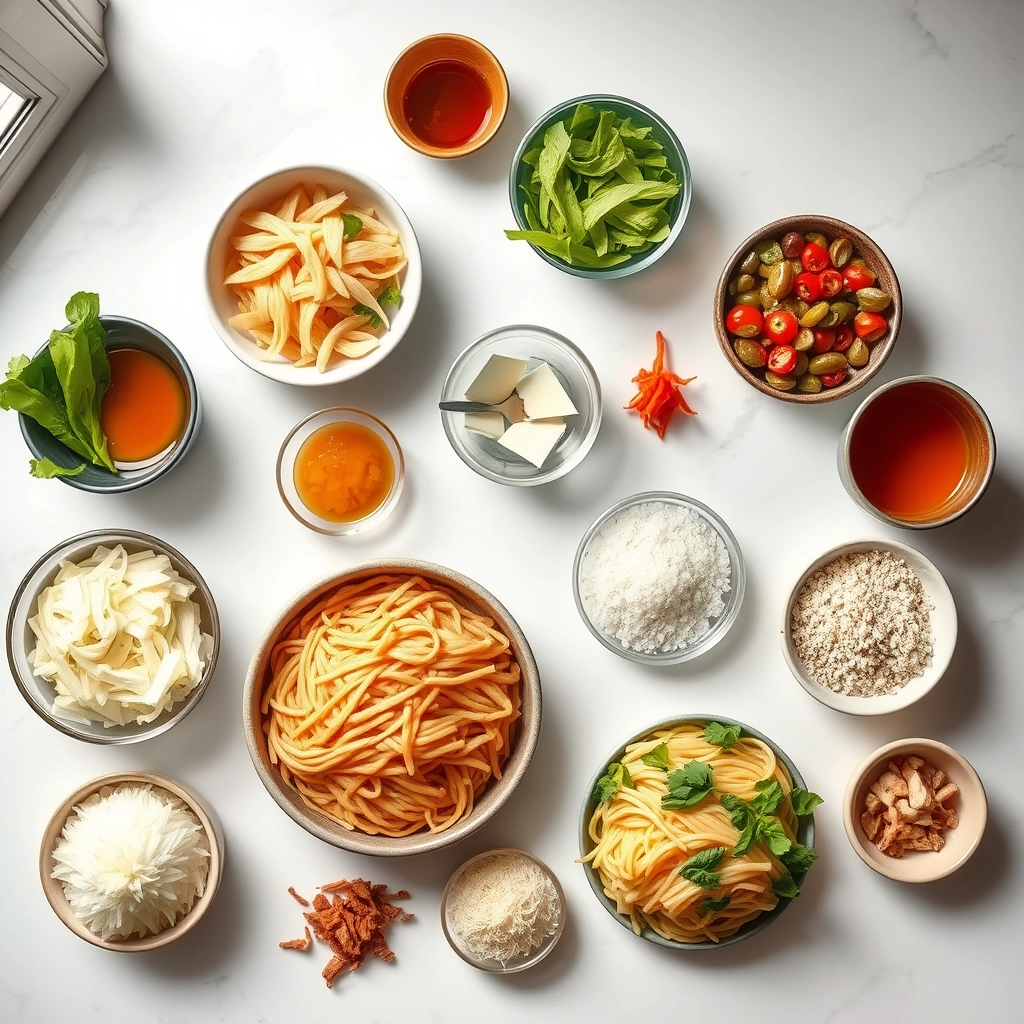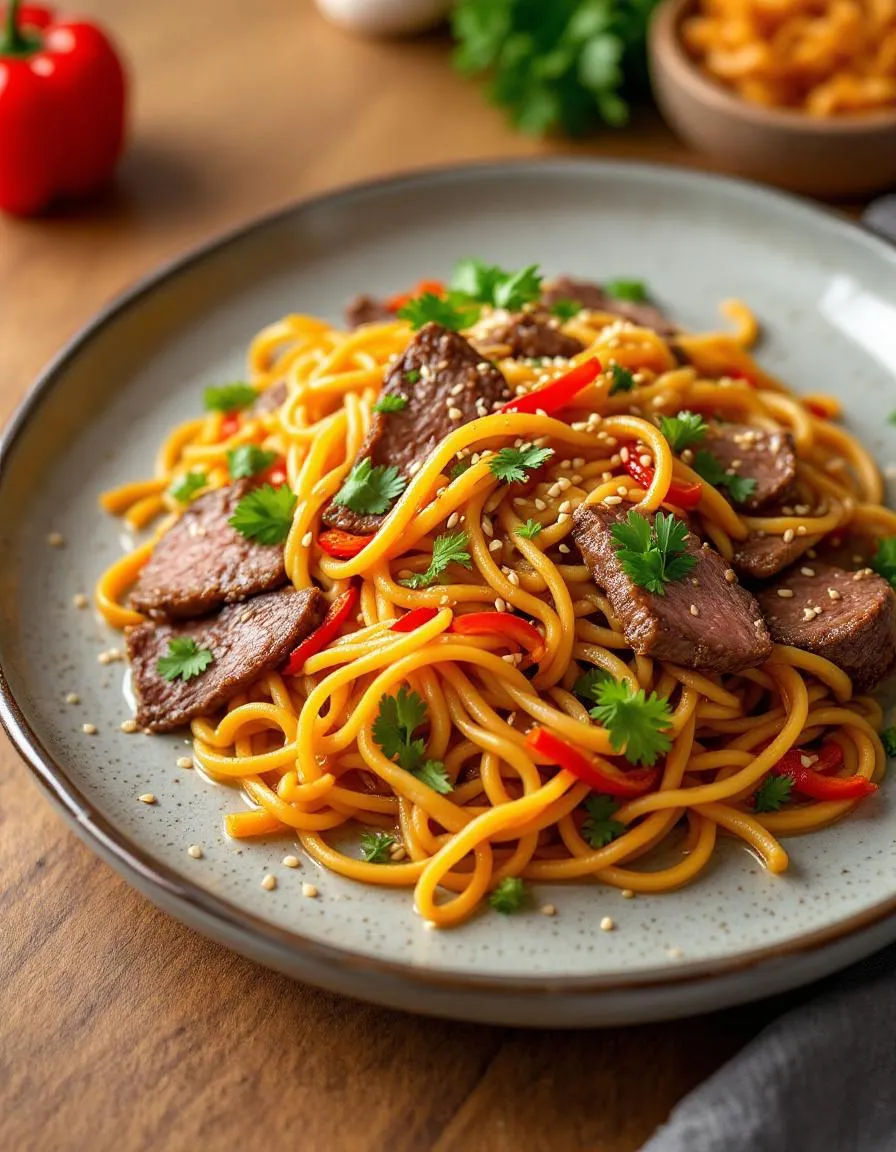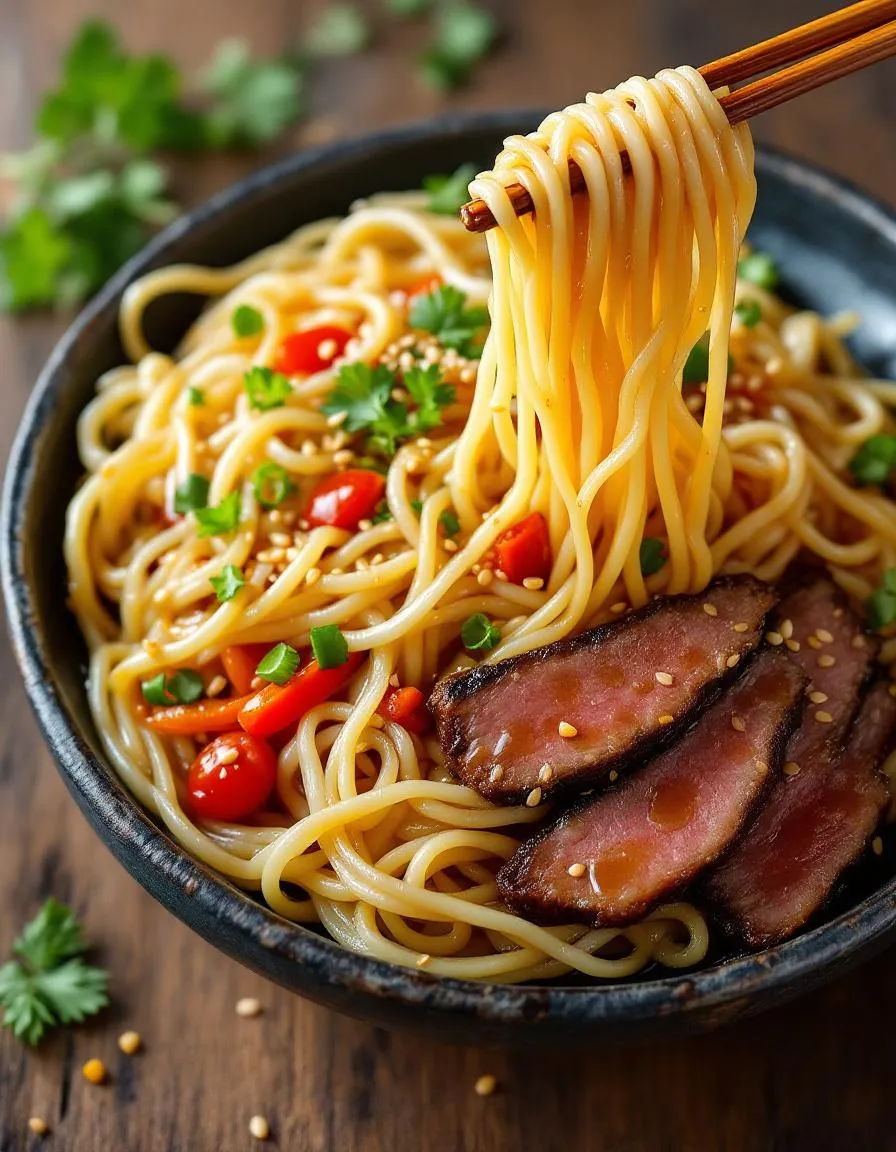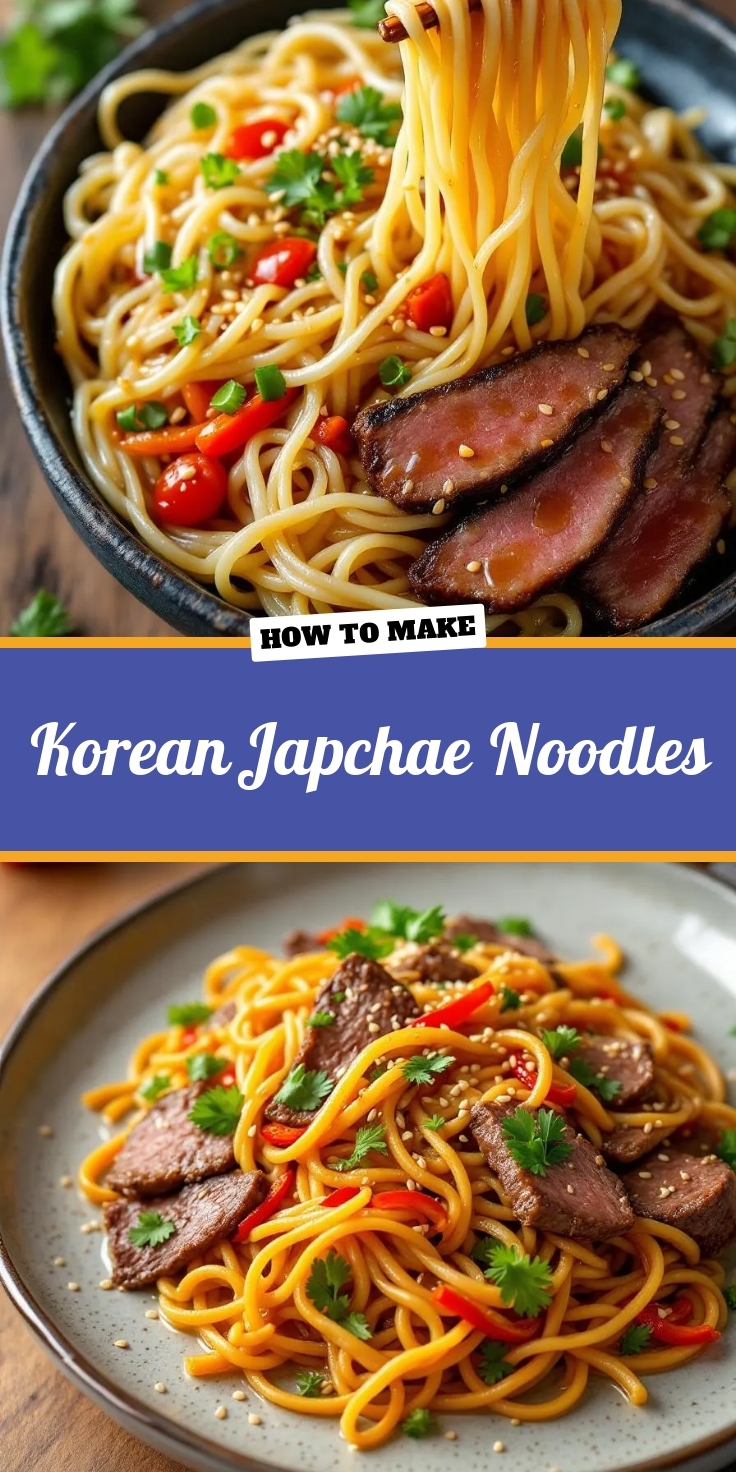Introduction
Hi there! I’m Emily, the heart and soul behind brekcakes.com. From my earliest memories, the kitchen has always been a place of warmth and creativity. It’s where I discovered the magic of turning simple ingredients into extraordinary meals and learned that the best dishes are often made with love as the main ingredient.
If you’ve ever craved a dish that’s both comforting and vibrant, Korean Japchae Noodles will steal your heart. This stir-fried glass noodle dish bursts with colorful vegetables, tender meat, and a savory-sweet sauce that dances on your palate. Whether you’re new to Korean cuisine or a longtime fan, this recipe brings joy to the table and connects people through every flavorful bite. Plus, it’s surprisingly easy to make at home, even on busy weeknights.
Korean Japchae Noodles, or simply Japchae, is a beloved Korean dish that celebrates balance and texture. Traditionally served at celebrations, it features chewy sweet potato noodles (dangmyeon) stir-fried with thinly sliced beef, mushrooms, spinach, carrots, and onions. The secret lies in the glossy, umami-rich sauce made with soy sauce, sesame oil, and a touch of sweetness. What makes it special? Unlike other noodle dishes, Japchae shines because it’s hearty yet light, savory yet slightly sweet, and endlessly adaptable. For instance, you can swap beef for tofu or load up on seasonal veggies. If you love exploring global flavors, this dish fits perfectly alongside other favorites like Korean BBQ Beef Bowls or Kimchi Fried Rice. At brekcakes.com, we celebrate recipes that tell a story—and Japchae’s story is one of tradition, versatility, and pure deliciousness.
Why I Love This Recipe
Korean Japchae Noodles hold a special place in my kitchen because they remind me of shared meals and laughter. The first time I tasted Japchae, a Korean friend prepared it for a potluck, and I instantly fell in love with its harmonious flavors. Now, I make it for family gatherings, knowing it’ll bring everyone together. The dish’s flexibility also lets me get creative—sometimes I add extra mushrooms or a sprinkle of sesame seeds for crunch. Most importantly, it’s a recipe that feels like a hug in a bowl, and that’s the kind of food I love to share with you.
Health and Nutrition
Why it’s good for your body
Korean Japchae Noodles offer a delicious way to fuel your body with essential nutrients. First, the dish features sweet potato glass noodles, which provide a gluten-free source of complex carbohydrates. These noodles digest slowly, keeping your energy levels steady and preventing blood sugar spikes. Additionally, they pair perfectly with colorful vegetables like spinach, carrots, and bell peppers, which pack vitamins A and C for immune support.
Moreover, Korean Japchae Noodles often include lean protein from ingredients like beef or tofu. Protein helps repair muscles and keeps you feeling full longer. The sesame oil used in the recipe adds healthy fats, which support heart health and reduce inflammation. Together, these ingredients create a balanced meal that nourishes your body without weighing you down.
Finally, Korean Japchae Noodles deliver a satisfying umami flavor while remaining relatively low in calories. The dish avoids heavy sauces, relying instead on natural seasonings like soy sauce and garlic. Whether you enjoy it warm or chilled, this meal proves that healthy eating can also be flavorful and fun.
How it fits in a healthy lifestyle
Korean Japchae Noodles fit seamlessly into a balanced diet. If you follow a gluten-free lifestyle, the sweet potato noodles make this dish a safe and tasty option. For those focusing on heart health, the lean proteins and unsaturated fats from sesame oil align perfectly with dietary guidelines. Even meal preppers love how well the flavors hold up in the fridge, making it a practical choice for busy weeks.
Pairing Korean Japchae Noodles with other nutrient-dense meals, like our vegetable stir-fry, ensures variety in your diet. If you’re exploring plant-based proteins, try swapping the meat for extra tofu and checking out our tofu marinade guide for added flavor. With its versatility and wholesome ingredients, this dish helps you stay on track without sacrificing taste.
PrintKorean Japchae Noodles
Description
A delicious and colorful Korean stir-fried glass noodle dish with vegetables and meat.
Ingredients
For the Crust:
- 200g sweet potato starch noodles (dangmyeon)
- 100g beef (sirloin or ribeye), thinly sliced
- 1 carrot, julienned
- 1 red bell pepper, julienned
- 1 yellow bell pepper, julienned
- 1 cup spinach
- 4 shiitake mushrooms, sliced
- 2 cloves garlic, minced
- 3 tbsp soy sauce
- 2 tbsp sesame oil
- 1 tbsp sugar
- 1 tbsp vegetable oil
- 1 tsp toasted sesame seeds
- Salt and pepper to taste
Instructions
1. Prepare the Crust:
- Soak the sweet potato noodles in warm water for 20 minutes, then boil for 5 minutes until tender. Drain and rinse with cold water. Set aside.
- Marinate the beef with 1 tbsp soy sauce, 1 tsp sugar, and minced garlic for 10 minutes.
- In a pan, heat vegetable oil and stir-fry the beef until cooked. Remove and set aside.
- In the same pan, stir-fry each vegetable separately (carrots, bell peppers, spinach, mushrooms) with a pinch of salt. Remove each after cooking.
- Combine the noodles with remaining soy sauce, sesame oil, and sugar. Mix well.
- Add all cooked ingredients back to the pan with the noodles and stir-fry for 2-3 minutes. Adjust seasoning if needed.
- Garnish with toasted sesame seeds before serving.
Notes
You can customize the seasonings to taste.

How to Prepare This Dish
Steps and time-saving tips
Start by soaking the Korean Japchae noodles in hot water for 15 minutes until pliable but still slightly firm. Meanwhile, thinly slice your choice of vegetables—carrots, bell peppers, and spinach work great—and sauté them in sesame oil over medium heat until tender. Next, whisk together the sauce: soy sauce, brown sugar, minced garlic, and a splash of rice vinegar for balance. Drain the noodles thoroughly, then toss them in the skillet with the veggies. Drizzle the sauce over everything and stir-fry for 3-4 minutes until the flavors meld. For extra texture, sprinkle toasted sesame seeds on top just before serving. To save time, prep your veggies ahead or use pre-sliced stir-fry mixes from the store. If you’re short on stove space, cook the noodles and veggies in batches, then combine them at the end. The dish tastes even better after resting for 10 minutes, letting the noodles soak up the sauce.
Mistakes I’ve made and learned from
I once overcooked the Korean Japchae noodles, turning them mushy—now I set a timer and taste-test early. Another blunder? Skipping the sesame oil toasting step for the veggies, which left them bland. A reader tip from my stir-fry guide saved me: toasting in batches locks in flavor. I also learned the hard way that undrained noodles water down the sauce; now I press them in a colander with a paper towel. For more sauce-balancing tricks, my sauce hacks post breaks down how to adjust sweetness or saltiness without starting over. Trust me, a little patience with prep makes all the difference.

Cultural Connection and Variations
Where this recipe comes from
Korean Japchae Noodles tell a story of celebration and tradition. Originally, this dish appeared in the 17th century as a royal court favorite, made with just vegetables and mushrooms. Over time, sweet potato noodles became the star, turning it into the beloved stir-fry we know today. Families often serve Korean Japchae Noodles during holidays like Lunar New Year, symbolizing good fortune with its vibrant mix of colors and textures.
Across Korea, regional twists pop up. Some coastal towns add squid or shrimp, while inland versions might feature extra mushrooms or lean beef. In my family, we toss in extra carrots and spinach for a crunchier bite. Meanwhile, Korean-American kitchens might swap ingredients like bell peppers or even add a dash of sriracha for heat. No matter the variation, the dish always balances sweet, savory, and chewy perfection.
How it fits in today’s cooking
Today, Korean Japchae Noodles shine as both a party staple and a quick weeknight fix. Busy cooks love its make-ahead flexibility, and meal preppers often pair it with easy Korean side dishes for balanced lunches. Plus, its gluten-free noodles and veggie-packed profile fit modern diets effortlessly.
During holidays, it anchors feasts alongside dishes like Korean BBQ at home, but it’s just as cozy on a random Tuesday. Some chefs even turn it into a salad by serving it chilled, or add tofu for a plant-powered twist. However you spin it, Korean Japchae Noodles keep bridging tradition and today’s kitchen rhythms.
Taste and Texture
What makes it delicious
Korean Japchae Noodles deliver a symphony of flavors and textures that make every bite irresistible. The glassy sweet potato noodles soak up the savory-sweet sauce, offering a satisfyingly chewy yet tender mouthfeel. Meanwhile, the stir-fried vegetables—like crisp carrots and earthy shiitake mushrooms—add layers of crunch and umami depth. A hint of toasted sesame oil wraps everything in a warm, nutty aroma, while the subtle sweetness from the soy-based glaze balances the dish perfectly. Together, these elements create a harmonious blend that makes Korean Japchae Noodles a standout comfort food.
Boosting the flavor
Elevate your Korean Japchae Noodles with a few creative tweaks. For extra richness, toss in thinly sliced beef or swap the mushrooms for king oyster varieties, which add a meaty texture. A sprinkle of toasted sesame seeds or a drizzle of spicy gochujang sauce introduces a fiery kick. If you love brightness, garnish with fresh scallions or a squeeze of lime. For more inspiration, explore our guide to Asian noodle bowls to pair complementary sides. Small changes can transform this classic dish into your new favorite meal.

Tips for Success
Best practices for results
Always soak the Korean Japchae Noodles for the full recommended time to ensure the perfect chewy texture. Meanwhile, stir-fry the vegetables separately to retain their crispness before combining them with the noodles. For the best flavor, use toasted sesame oil as a finishing touch, and toss everything gently to avoid breaking the noodles. Finally, taste and adjust the seasoning just before serving to balance the sweet and savory notes.
Mistakes to avoid
Overcooking the noodles is a common mistake that turns them mushy, so stick to the package instructions and rinse them under cold water immediately after draining. Another issue is skipping the toasting step for the sesame seeds, which reduces their nutty flavor—lightly toast them for maximum impact. If you need more guidance on balancing flavors, check out our guide on seasoning tips. Also, avoid overcrowding the pan when stir-frying, as this steams the vegetables instead of searing them. For better techniques, explore our stir-fry methods to keep your Korean Japchae Noodles perfectly textured.
Serving and Pairing Suggestions
How to serve this dish
Korean Japchae Noodles shine when served family-style on a large platter, allowing everyone to dig in. For a festive touch, garnish with toasted sesame seeds and thin strips of colorful bell peppers. Alternatively, portion individual servings into small bowls for a polished look at brunch or potlucks. Since the dish boasts vibrant ingredients like carrots and spinach, arrange them thoughtfully to highlight its natural beauty. Whether you’re hosting a holiday gathering or a casual weeknight dinner, Korean Japchae Noodles always impress with their balance of textures and flavors.
What goes well with it
Pair Korean Japchae Noodles with a light cucumber kimchi salad for a refreshing contrast to the savory noodles. The crisp acidity cuts through the dish’s richness perfectly. For heartier meals, serve it alongside Korean BBQ beef, which adds a smoky depth. Meanwhile, a chilled glass of barley tea balances the flavors with its nutty, slightly bitter notes. Each pairing enhances the dish without overpowering its delicate sweetness.

Korean Japchae noodles are made from sweet potato starch, giving them a chewy, translucent texture. The dish typically includes stir-fried vegetables, protein like beef or tofu, and a savory-sweet sauce made with soy sauce, sesame oil, and sugar.
Traditional Korean Japchae noodles are gluten-free since they’re made from sweet potato starch. However, always check the sauce ingredients, as some soy sauces contain wheat. For a fully gluten-free version, use tamari instead of regular soy sauce.
To prevent Korean Japchae noodles from sticking, rinse them in cold water after boiling and toss with a little sesame oil. Stir-fry them quickly with the other ingredients and serve immediately for the best texture.
Yes, Korean Japchae noodles can be enjoyed both hot and cold. The dish is often served at room temperature in Korea, making it perfect for picnics or bento boxes. The flavors actually develop more when chilled overnight.

